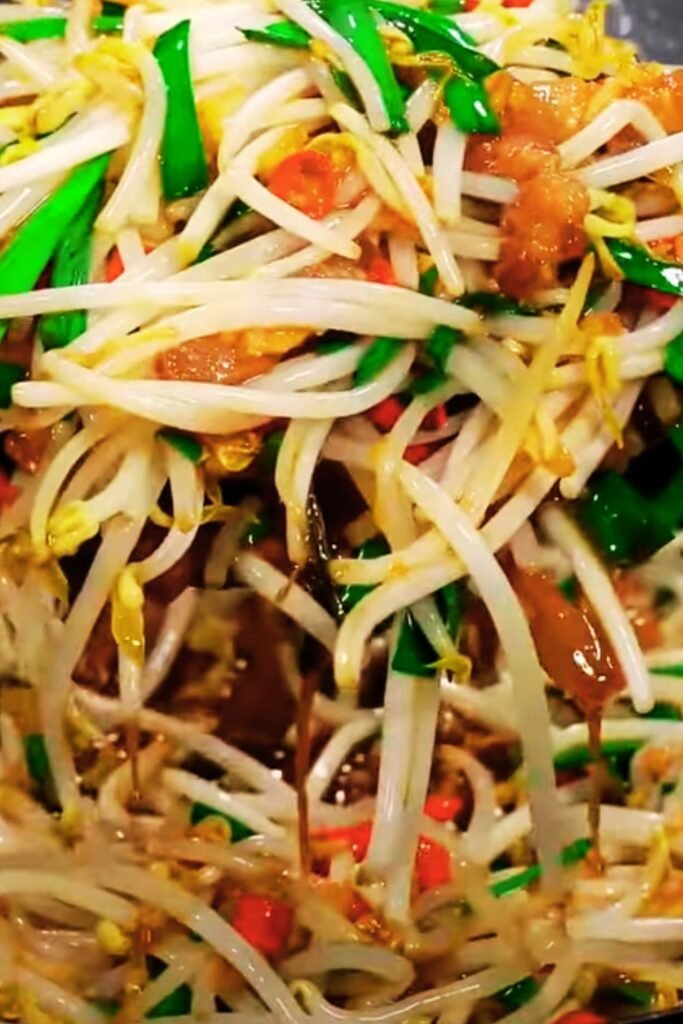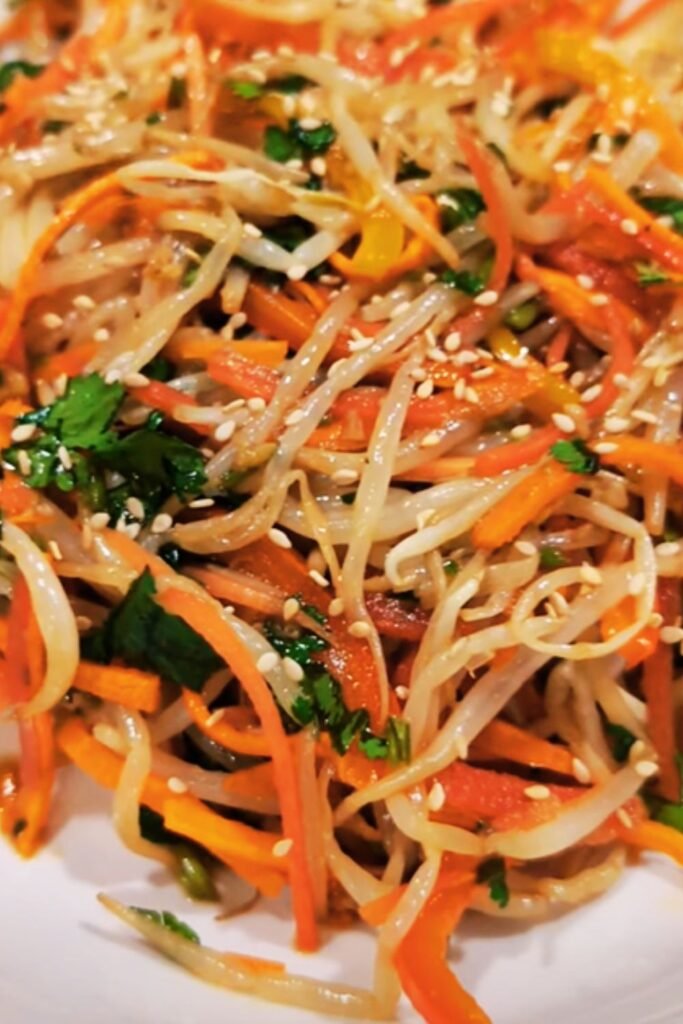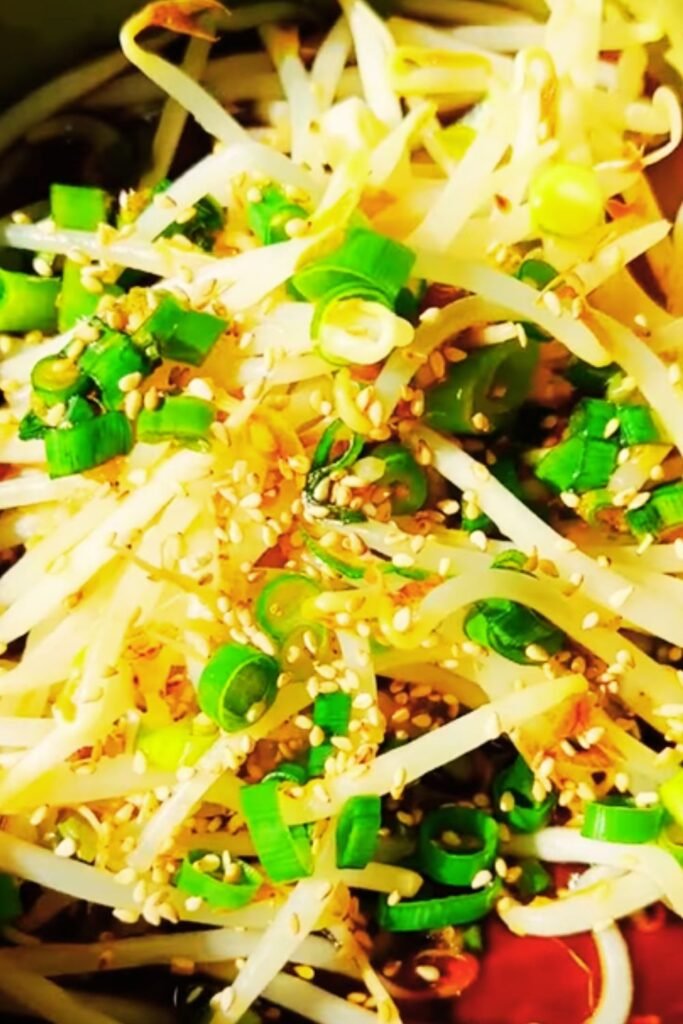There’s something magical about the humble bean sprout. When I first discovered Japanese bean sprouts salad (or moyashi salad as it’s called in Japan), I was immediately captivated by its simplicity and vibrant flavors. This unassuming side dish transformed my view of bean sprouts forever, elevating them from a mere stir-fry addition to the star of the show.
In Japan, bean sprout salad is a staple in many households, appearing regularly on dinner tables as a refreshing side. What makes this dish truly special is how it balances crisp textures with savory depth, all while being incredibly nutritious and affordable.
Today, I’m excited to share my perfected recipe for Japanese bean sprouts salad—a dish that takes just minutes to prepare but delivers a symphony of flavors that will have you coming back for seconds. Whether you’re looking for a quick side dish, a light lunch option, or simply want to expand your repertoire of Japanese home cooking, this bean sprout salad recipe is a must-try.
What Makes Japanese Bean Sprouts Salad Special?
Before diving into the recipe, let me tell you why this dish stands out among other salads. Unlike many Western salads that rely heavily on leafy greens, Japanese bean sprout salad celebrates the crisp texture of blanched bean sprouts. The key is in the preparation—quickly blanching the sprouts preserves their satisfying crunch while removing any raw bean taste.
The dressing is equally important, typically featuring a balanced combination of soy sauce, sesame oil, rice vinegar, and other umami-rich ingredients. This creates a perfect harmony of flavors that enhances the natural sweetness of the bean sprouts without overwhelming them.
What I love most about this salad is its versatility. You can enjoy it immediately while still warm, or chill it for a cool, refreshing side dish. It’s perfect for meal prep as it actually tastes even better after the flavors have had time to meld together in the refrigerator.
Health Benefits of Bean Sprouts
Bean sprouts aren’t just delicious—they’re nutritional powerhouses. Here’s why they deserve a place in your regular meal rotation:
- Low in calories: Bean sprouts contain approximately 30 calories per cup, making them an excellent choice for those monitoring calorie intake.
- High in fiber: They provide a good amount of dietary fiber, supporting digestive health.
- Rich in vitamins: Bean sprouts are packed with vitamin C, vitamin K, and various B vitamins.
- Good source of minerals: They contain essential minerals like iron, potassium, and magnesium.
- Protein-packed: Despite their light nature, bean sprouts offer a decent amount of plant-based protein.
When I was trying to incorporate more nutrient-dense foods into my diet without adding significant calories, bean sprouts became my go-to ingredient. This salad, in particular, has become my favorite way to enjoy their benefits while satisfying my taste buds.
Ingredients for Japanese Bean Sprouts Salad
For this recipe, I’ve refined the proportions to create the perfect balance of flavors. Here’s what you’ll need:
Main Ingredients:
- 1 pound (about 450g) fresh bean sprouts
- 2 green onions, finely sliced
- 1 small carrot, julienned (optional)
- 1 tablespoon toasted sesame seeds
- 1 sheet nori seaweed, cut into thin strips (optional)
For the Dressing:
- 2 tablespoons soy sauce (preferably Japanese)
- 1 tablespoon sesame oil
- 1 tablespoon rice vinegar
- 1 teaspoon sugar or honey
- 1 teaspoon grated fresh ginger
- 1 small garlic clove, minced (optional)
- ¼ teaspoon red pepper flakes (adjust to taste)
Optional Add-ins:
- ¼ cup thinly sliced cucumber
- 2 tablespoons shredded wakame seaweed (rehydrated)
- Half a red bell pepper, thinly sliced
- 1 tablespoon crushed roasted peanuts
Equipment Needed
One of the things I appreciate most about this recipe is how little equipment you need:
- Large pot for blanching
- Colander or strainer
- Ice bath (large bowl with ice and water)
- Small bowl for mixing dressing
- Large mixing bowl
- Measuring spoons
- Cutting board and knife
Step-by-Step Instructions
Now, let’s get cooking! Follow these simple steps to create a perfect Japanese bean sprouts salad:
Step 1: Prepare the Bean Sprouts
- Rinse the bean sprouts thoroughly under cold running water.
- Remove any remaining roots or discolored sprouts (though most commercially sold sprouts come cleaned).
- Bring a large pot of water to a rolling boil. Do not add salt at this stage.
- Prepare an ice bath by filling a large bowl with cold water and ice cubes.
Step 2: Quick-Blanch the Bean Sprouts
This is where many people go wrong with bean sprouts. The secret is in the timing—too long and they become mushy; too short and they remain too raw.
- Once the water is boiling vigorously, add the bean sprouts.
- Blanch for exactly 60-90 seconds—just enough to take away the raw taste but preserve the crunch.
- Quickly drain the sprouts in a colander.
- Immediately transfer them to the ice bath to stop the cooking process.
- After 1-2 minutes in the ice bath, drain the bean sprouts thoroughly.
- To remove excess moisture (crucial for a crisp salad), gently press the sprouts between paper towels or a clean kitchen towel.

Step 3: Prepare the Dressing
While the bean sprouts are cooling down:
- In a small bowl, combine soy sauce, sesame oil, rice vinegar, and sugar or honey.
- Add the grated ginger, minced garlic (if using), and red pepper flakes.
- Whisk thoroughly until the sugar is dissolved and ingredients are well combined.
- Taste and adjust seasonings as needed—the dressing should be balanced between savory, tangy, and slightly sweet.
Step 4: Combine and Marinate
- Place the drained bean sprouts in a large mixing bowl.
- Add the sliced green onions, julienned carrots (if using), and any optional add-ins.
- Pour the dressing over the ingredients.
- Gently toss everything together until the bean sprouts are evenly coated with the dressing.
- Let the salad marinate for at least 15 minutes at room temperature, or refrigerate for up to 1 hour.
Step 5: Final Touches and Serving
- Just before serving, sprinkle the toasted sesame seeds over the salad.
- If using, add the nori strips on top.
- Give everything one final gentle toss.
- Transfer to a serving bowl and enjoy!

Storage Tips
I often make a double batch of this salad because it stores beautifully:
- Refrigeration: Store leftovers in an airtight container in the refrigerator for up to 2 days.
- Before serving leftovers: Drain any accumulated liquid and give the salad a quick toss.
- Reviving texture: If stored salad becomes too soft, briefly reblanche fresh bean sprouts and mix them with the leftover salad for added crunch.
Nutrition Information
For those who are health-conscious or simply curious about what they’re eating, here’s a breakdown of the nutritional content per serving (approximately 1 cup) of Japanese bean sprouts salad:
| Nutrient | Amount | % Daily Value* |
|---|---|---|
| Calories | 78 | – |
| Total Fat | 5g | 6% |
| Saturated Fat | 0.7g | 3% |
| Cholesterol | 0mg | 0% |
| Sodium | 336mg | 14% |
| Total Carbohydrate | 6g | 2% |
| Dietary Fiber | 2.5g | 9% |
| Sugars | 2g | – |
| Protein | 3g | 6% |
| Vitamin C | 15mg | 17% |
| Calcium | 26mg | 2% |
| Iron | 1.2mg | 7% |
| Potassium | 216mg | 5% |
*Percent Daily Values are based on a 2,000 calorie diet.
Variations of Japanese Bean Sprouts Salad
Over the years, I’ve experimented with numerous variations of this classic recipe. Here are some of my favorite adaptations:
Spicy Version
For those who enjoy heat, try adding:
- 1 tablespoon of gochujang (Korean chili paste)
- Extra red pepper flakes
- A drizzle of chili oil just before serving
Protein-Packed Version
Transform this side dish into a main meal by adding:
- ½ cup of cubed firm tofu (pan-seared or raw)
- ¼ cup of cooked edamame
- 2 tablespoons of crushed peanuts or cashews
Seafood Version
For seafood lovers:
- Add ¼ cup of cooked and chilled baby shrimp
- Mix in 2 tablespoons of finely diced octopus (pre-cooked)
- Include a tablespoon of tobiko (flying fish roe) for a burst of color and flavor
Vegetable-Forward Version
Load up on extra vegetables:
- ½ cup of thinly sliced bell peppers (multicolored for visual appeal)
- ¼ cup of julienned daikon radish
- 2 tablespoons of corn kernels
Serving Suggestions
This versatile salad pairs beautifully with a variety of dishes. Here are some of my favorite ways to serve it:
- As part of a Japanese home-style meal with grilled fish, miso soup, and steamed rice
- Alongside gyoza (Japanese dumplings) for a light lunch
- With teriyaki chicken or salmon for a protein-rich dinner
- In a bento box for a balanced packed lunch
- As a refreshing side dish with yakitori (Japanese grilled chicken skewers)
- Topped with a soft-boiled egg for a more substantial starter
For a refreshing non-alcoholic drink pairing, I recommend:
- Cold barley tea (mugicha)
- Yuzu citrus infused sparkling water
- Unsweetened green tea

Common Mistakes to Avoid
Through trial and error, I’ve identified several pitfalls when making bean sprout salad. Here’s how to avoid them:
Overcooking the Bean Sprouts
- Issue: Bean sprouts turn mushy and lose their signature crunch.
- Solution: Stick to a strict 60-90 second blanching time and use an ice bath immediately after.
Under-draining the Sprouts
- Issue: Excess water dilutes the dressing and makes the salad soggy.
- Solution: After the ice bath, drain thoroughly and gently press between paper towels.
Over-dressing the Salad
- Issue: Too much dressing overwhelms the delicate flavor of the sprouts.
- Solution: Start with less dressing than you think you need; you can always add more.
Not Allowing Marination Time
- Issue: Flavors don’t properly penetrate the bean sprouts.
- Solution: Allow at least 15 minutes for the sprouts to absorb the dressing flavors.
Using Old Bean Sprouts
- Issue: Older sprouts can be stringy or bitter.
- Solution: Always use the freshest bean sprouts available; look for crisp, white sprouts with minimal yellowing.
Seasonal Adaptations
While bean sprouts are available year-round, you can adapt this salad to reflect seasonal changes:
Spring Version
- Add thinly sliced asparagus (briefly blanched)
- Include some fresh pea shoots
- Mix in a few cherry blossom petals (if available and edible) for a special touch
Summer Version
- Add thin slices of cucumber for extra refreshment
- Include some shredded shiso leaves for aromatic freshness
- Serve extra chilled
Fall Version
- Add julienned persimmon for sweetness
- Include toasted pumpkin seeds instead of sesame seeds
- Add a dash of yuzu kosho for warmth
Winter Version
- Mix in some blanched and thinly sliced daikon radish
- Add yuzu zest for citrusy brightness
- Serve slightly warmer (room temperature rather than chilled)
The Cultural Significance of Bean Sprouts in Japanese Cuisine
Bean sprouts, or moyashi, hold a special place in Japanese culinary tradition. They symbolize growth and new beginnings, which is why they’re often featured in dishes served during the New Year celebrations.
In traditional Japanese medicine, bean sprouts are considered cooling foods that help balance the body during hot summer months. This belief aligns perfectly with modern nutritional understanding of their hydrating nature and high vitamin content.
What fascinates me most is how Japanese cuisine transforms this humble ingredient into something truly special. Bean sprouts are not merely a filler or garnish but are elevated to a celebrated ingredient worthy of being the focal point of a dish.
Frequently Asked Questions
After sharing this recipe with friends and family, I’ve collected these common questions:
What type of bean sprouts should I use? For authentic Japanese bean sprout salad, mung bean sprouts are preferred. They’re thinner and crispier than soybean sprouts. However, both types work well with this recipe. I find mung bean sprouts have a sweeter, cleaner taste that pairs beautifully with the dressing.
Can I make this salad without blanching the bean sprouts? While you technically can use raw bean sprouts, I strongly recommend blanching. Raw sprouts can carry a slight bitterness and have an enzyme that some find difficult to digest. The quick blanching process neutralizes this while maintaining the essential crunch. If you’re concerned about nutrient loss, remember that the ultra-brief blanching preserves most of the nutritional value.
How can I make this salad more filling? To transform this side dish into a main meal, add protein such as tofu, edamame, or cooked shrimp. You can also serve it over a small portion of soba noodles or brown rice for a more substantial dish. I particularly enjoy adding a soft-boiled egg with a slightly runny yolk; when mixed in, it creates a rich, creamy element to the salad.
Is this recipe gluten-free? The base recipe isn’t gluten-free due to the regular soy sauce. However, you can easily make it gluten-free by substituting with tamari or certified gluten-free soy sauce. Always check your sesame oil labels as well, as some brands may have gluten cross-contamination.
Can I prepare this salad in advance for a party? Absolutely! In fact, preparing it 1-2 hours ahead allows the flavors to develop more fully. If preparing further in advance, I recommend blanching and drying the bean sprouts, preparing the dressing separately, and combining them about an hour before serving. This ensures the sprouts remain crisp rather than becoming soggy from sitting too long in the dressing.
What’s the best way to toast sesame seeds? For maximum flavor, toast sesame seeds in a dry skillet over medium heat, shaking frequently, for about 2-3 minutes until they turn golden and become fragrant. Watch them carefully as they can burn quickly! Allow them to cool completely before adding to your salad. I often toast extra seeds to keep in an airtight container for future use.
Can I use pre-made dressing? While convenient, pre-made dressings won’t deliver the same fresh, balanced flavor as homemade. If you’re in a pinch, look for a ponzu or sesame-ginger dressing, but be prepared to adjust with additional seasoning as needed. The few minutes it takes to make the dressing from scratch truly elevates this simple dish.
Final Thoughts
Japanese bean sprouts salad represents everything I love about Japanese cuisine—simplicity, balance, and respect for ingredients. What begins as a humble bag of bean sprouts transforms into a vibrant, nutritious dish that can complement almost any meal.
The beauty of this recipe lies in its adaptability. Once you master the basic technique, you can customize it endlessly to suit your taste preferences or what you have available in your refrigerator. It’s this kind of flexible yet foundational recipe that I believe everyone should have in their culinary repertoire.
Whether you’re just beginning to explore Japanese cooking or you’re a seasoned home chef looking to expand your side dish options, this bean sprout salad is a wonderful addition to your recipe collection. It’s economical, nutritious, quick to prepare, and—most importantly—absolutely delicious.
I hope you enjoy making and eating this salad as much as I do. It’s taught me that sometimes the simplest ingredients, when treated with care and respect, can create the most satisfying dishes.